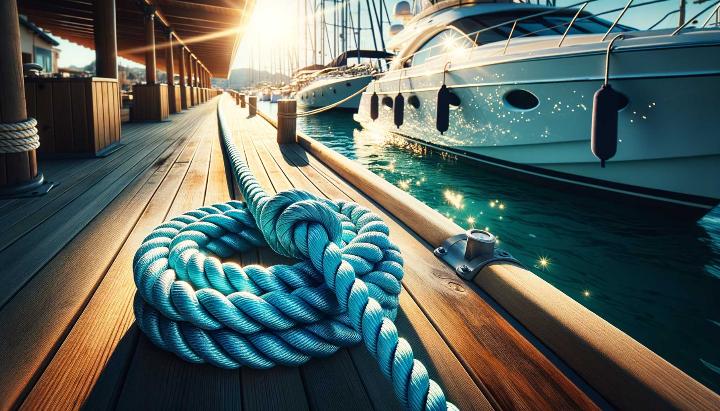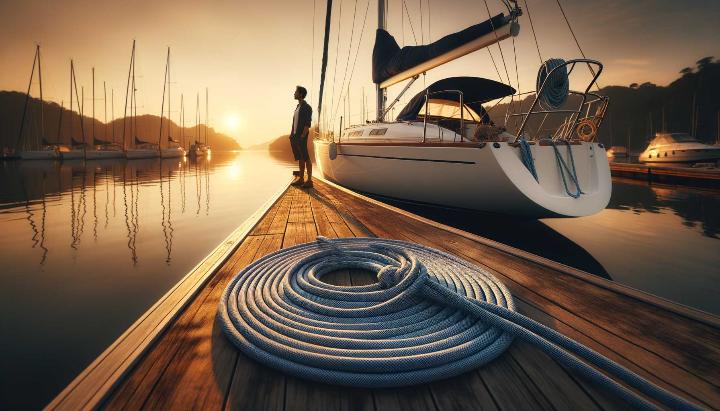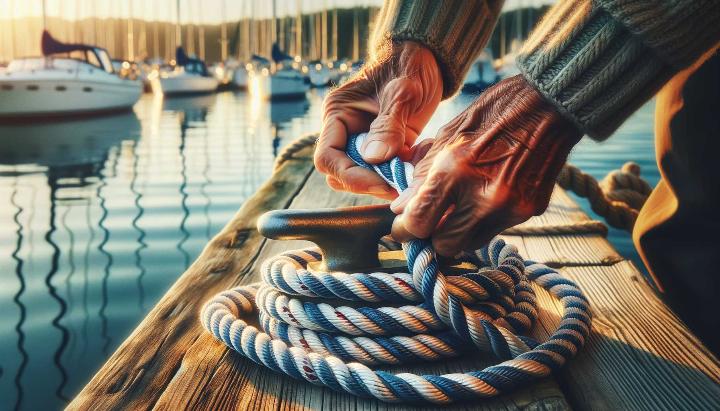Have you ever wondered why some boats seem to dance gracefully with the waves, while others struggle against the tide? The secret lies in the unsung hero of marine safety: the double braid nylon dock line. These remarkable ropes are the lifeline between your vessel and the dock, silently working to keep your maritime adventures afloat.
At iRopes, we've seen firsthand how the right dock line can make all the difference. Our double braid nylon dock lines are more than just ropes; they're a fusion of cutting-edge technology and time-honoured craftsmanship. With a structure that combines inner and outer braids of nylon, these lines offer unparalleled strength and flexibility. But that's not all – we've pushed the boundaries by blending nylon with advanced materials like UHMWPE, KEVLAR, TECHNORA, and VECTRAN, creating dock lines that are truly in a class of their own.
In this post, we'll dive deep into the world of double braided nylon lines, exploring their unique structure, benefits, and how to choose the perfect line for different parts of your hull. Whether you're a seasoned sailor or a weekend warrior, understanding these crucial components of your boat's safety system could be the difference between a smooth sail and a nautical nightmare. So, are you ready to unlock the secrets of superior docking? Let's cast off and explore the fascinating world of double braid nylon dock lines!
Understanding the Structure of Double Braid Nylon Dock Lines
As a seasoned sailor, I've come to appreciate the intricate design of double braid nylon dock lines. These unassuming ropes play a crucial role in keeping our beloved vessels safe and secure. Let's dive into the fascinating world of their structure and composition.
Composition and Materials of Double Braid Dock Lines
Double braid nylon dock lines are a marvel of engineering, combining strength and flexibility in a single package. The construction consists of two key components:
- Inner core: This is the heart of the line, providing the bulk of its strength.
- Outer jacket: This protective layer enhances durability and handling characteristics.
Both layers are typically made of nylon, a material cherished by boaters for its remarkable properties. Have you ever wondered why nylon is the go-to choice for dock lines? It's all about the perfect balance of attributes:
- Exceptional strength: Nylon can withstand high loads without breaking.
- Impressive elasticity: It stretches to absorb shock, protecting both your boat and the dock.
- Resistance to abrasion: Nylon stands up well to the wear and tear of marine environments.
- UV resistance: It maintains its integrity even under harsh sunlight exposure.

Strength and Durability Characteristics
One of the most impressive features of double braid nylon dock lines is their remarkable breaking strength. Depending on the size, these lines can withstand loads from 4,800 to a whopping 7,700 pounds! But remember, it's not just about raw strength – the durability of these lines is equally important.
To ensure your dock lines last as long as possible, here are a few maintenance tips I've picked up over the years:
- Regular inspections: Check for signs of wear, especially at connection points.
- Proper storage: Keep lines out of direct sunlight when not in use.
- Rinse with fresh water: This helps remove salt and debris after each use.
- Rotate usage: Alternate the ends you tie to distribute wear evenly.
By understanding the structure and caring for your double braid nylon dock lines, you're not just protecting your investment – you're ensuring the safety and security of your vessel. Isn't it amazing how such a seemingly simple rope can be so crucial to our boating adventures?
Benefits of Using Double Braided Nylon Line for Docking
As a seasoned boater, I've learned that choosing the right dock line can make all the difference in keeping your vessel safe and secure. Double braided nylon lines have become my go-to choice, and for good reason. Let's dive into the remarkable benefits these lines offer for docking applications.
Strength and Durability Advantages
When it comes to mooring your boat, strength is paramount. Double braided nylon lines outperform their 3-strand counterparts by a significant margin. In my experience, a 1/2-inch double braid nylon line can handle a breaking strength of around 2100 pounds, compared to just 1700 pounds for a 3-strand rope of the same diameter. This extra strength provides peace of mind, especially when facing choppy waters or unexpected weather changes.
But it's not just about raw strength. The durability of double braided nylon lines is truly impressive. I've had mine withstand years of sun exposure, salt water, and constant use without significant degradation. The UV resistance of nylon plays a crucial role here, maintaining the line's integrity even under harsh Australian sun.

Flexibility and Handling Characteristics
One of the standout features of double braided nylon lines is their exceptional flexibility. Have you ever struggled with stiff, uncooperative ropes when trying to secure your boat quickly? I certainly have, and it's not an experience I'd care to repeat. Double braided lines, on the other hand, are a joy to handle. They coil easily and store compactly, making them perfect for boats where space is at a premium.
But the real magic happens when these lines are put to work. The shock absorption properties of nylon are truly remarkable. I've watched my double braided lines stretch and flex under sudden loads, protecting both my boat's cleats and the dock from potential damage. This elasticity is crucial in accommodating tidal changes and the natural movement of your vessel, ensuring a secure hold without putting undue stress on your boat's hardware.
- Superior shock absorption: Protects your boat and dock from sudden jerks and impacts.
- Excellent stretch characteristics: Accommodates tidal changes and boat movements seamlessly.
- Easy handling and storage: Coils effortlessly and takes up minimal space on board.
In my years of boating, I've found that the combination of strength, durability, and flexibility offered by double braided nylon lines is unmatched. Whether you're dealing with a calm marina or facing more challenging docking conditions, these lines provide the reliability and performance you need to keep your vessel secure. Isn't it time you experienced the difference for yourself?
Selecting the Right Double Braid Nylon Dock Line for Different Parts of the Hull
As a seasoned boater, I've learned that choosing the right double braid nylon dock line isn't just about picking any rope off the shelf. It's an art that requires careful consideration of your boat's unique needs. Let's dive into the specifics of selecting the perfect dock lines for each part of your hull.
Bow and Stern Lines: Your Boat's Primary Anchors
When it comes to bow and stern lines, think thick and long. These are your boat's primary anchors, bearing the brunt of the forces acting on your vessel. I remember the time I underestimated the importance of robust bow lines during a particularly gusty day at the marina. Let's just say it was a lesson learned the hard way!
- Thickness matters: For boats up to 25 feet, go for 3/8" lines. If your vessel is between 25-35 feet, opt for 1/2" lines. Larger boats in the 35-45 foot range need 5/8" lines for optimal security.
- Length is key: A good rule of thumb is to choose lines that are at least 2/3 the length of your boat. This extra length provides the flexibility needed to accommodate tidal changes and boat movements.
Spring Lines: The Unsung Heroes of Docking
Spring lines are often overlooked, but they're crucial in preventing fore and aft movement. Positioned diagonally, these lines work tirelessly to keep your boat steady. I've seen many a novice boater struggle with positioning spring lines correctly. Here's a tip: think of them as the 'X' factor in your docking setup.
- Ideal positioning: Run one spring line from the bow to a midship cleat on the dock, and another from the stern to a forward dock cleat. This creates an 'X' pattern that minimizes movement.
- Length consideration: Spring lines should be about the same length as your boat for optimal performance.
Breast Lines: Your Lateral Movement Guardians
Breast lines are your defense against lateral movement, keeping your boat snug against the dock. They're particularly important in areas with strong crosswinds or heavy boat traffic that can cause wake.
- Positioning is crucial: Set these lines perpendicular to your boat, running from the boat's cleats to the dock cleats directly opposite.
- Length matters here too: Breast lines should be just long enough to allow for some vertical movement with tides, but short enough to prevent excessive lateral motion.

Choosing the Right Thickness and Length
Selecting the appropriate line thickness and length isn't just about following a chart – it's about understanding your specific docking conditions. Here's a quick guide to get you started:
- Boat length to line diameter ratio: A good rule of thumb is 1/8" of line diameter for every 9 feet of boat length. This ensures your lines can handle the loads your boat may experience.
- Consider your docking environment: If you're in an area prone to strong winds or currents, you might want to go up a size in diameter for added security.
- Factor in freeboard: Boats with higher freeboard may need longer lines to accommodate the extra height.
Remember, these are general guidelines. Your specific needs may vary based on your boat's design, local weather conditions, and personal preferences. Don't be afraid to experiment and find what works best for your vessel. After all, that's part of the joy of boating, isn't it?
By selecting the right double braid nylon dock lines for each part of your hull, you're not just securing your boat – you're ensuring peace of mind every time you leave the dock. And in my book, that's priceless.
Customizing Double Braided Line for Specific Applications
As a long-time boating enthusiast, I've come to appreciate the versatility of double braided lines. These robust ropes aren't just a one-size-fits-all solution; they can be tailored to meet the unique demands of various marine applications. Let's dive into the world of customizing double braided lines and explore how you can optimize them for your specific needs.
Understanding Double Braid Rope Properties
Before we delve into customization, it's crucial to understand what makes double braid rope so special. The magic lies in its structure: a braided core encased in a braided outer sheath. This construction offers an unbeatable combination of strength and flexibility.
- Core strength: The inner braid provides the bulk of the rope's tensile strength.
- Outer protection: The outer sheath offers abrasion resistance and handling comfort.
- Material matters: Typically made from nylon or polyester, each with its own unique properties.
Have you ever wondered why your dock lines feel so different from your sailing sheets? It's all in the customization!
Splicing Techniques for Double Braided Line
One of the most powerful customization tools in your arsenal is splicing. I remember the first time I attempted an eye splice on a double braid rope – it was a bit intimidating, but the results were worth it! To delve deeper into the art of splicing, check out our Mastering Rope Splice Techniques for Nylon and Winch Ropes.
Proper splicing can maintain up to 100% of the rope's strength, making it an essential skill for any serious boater. Here's a basic outline of the process:
- Mark the rope where you want the eye to begin.
- Extract the core from the cover for a short distance.
- Taper the core and reinsert it into the cover.
- Work the cover back over the core to form the eye.
Of course, there's more to it than that, but these are the fundamental steps. With practice, you'll be creating custom eyes and loops like a pro!

Tailoring Strength and Thickness to Meet Requirements
When it comes to customizing double braided line, strength and thickness are key considerations. The right combination can make all the difference in performance and longevity.
- Strength factors: Consider the maximum load your line will need to handle. For heavy-duty applications, you might want to opt for high-strength materials like UHMWPE or Kevlar blends.
- Thickness choices: Thicker lines generally offer more strength and durability, but they're also heavier and less flexible. It's all about finding the right balance for your needs.
- Application-specific customization: For example, a mooring line might require more stretch to absorb shock loads, while a halyard needs minimal stretch for optimal sail shape. Explore more about handling this in our Benefits of Nylon Rope Stretch for High-Performance Use.
Remember that time I used a too-thin line for my anchor rode? Let's just say it was a wake-up call about the importance of proper sizing!
Customizing your double braided lines isn't just about performance – it's also about peace of mind. Knowing that your lines are tailored to your specific needs can make all the difference when you're out on the water.
Have you ever customized your own double braided lines? What challenges did you face, and what solutions did you discover? Share your experiences in the comments below – your insights could be invaluable to fellow boaters!
```htmlChoosing the right dock line is crucial for boat safety, and double braid nylon dock lines stand out for their superior strength and flexibility. These lines, often crafted entirely from nylon, or combined with materials like polyester, UHMWPE, KEVLAR, TECHNORA, or VECTRAN, offer remarkable performance benefits. The double braided structure enhances durability and shock resistance, making them ideal for docking amidst tidal changes and boat movements. Tailored double braided line choices provide stability for different parts of the hull, ensuring lateral and vertical security. By understanding the features of a double braid nylon dock line, you can better protect your vessel while enjoying the peace of mind offered by resilience under marine conditions.
Discover Tailored Dock Line Solutions
Ready to enhance your docking setup with reliable double braided nylon line? Complete the inquiry form above for expert guidance on selecting the perfect dock lines for your needs. Our specialists are eager to assist in crafting a solution that ensures unmatched security and longevity for your vessel.
```